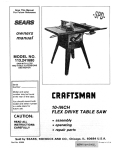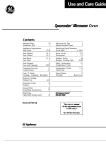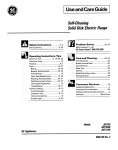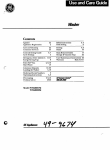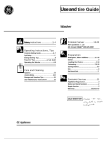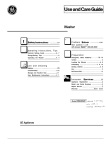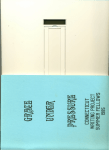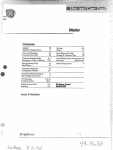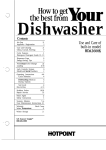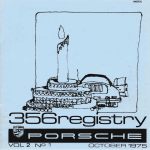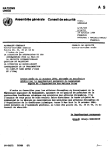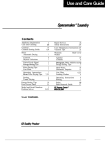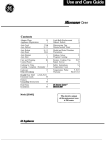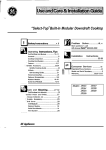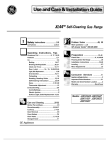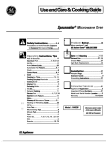Download GE WSM2700L User's Manual
Transcript
S~emaker”hundry
Gntenk
Appliance Registration
Care and Cleaning
Cautions
Controls Setting Guide
Dryer
Automatic Drying
2
25
41:
7
Controls
Dryness Selections
End-of-Cycle Signal
Energy-Saving Tips
Knits Drying Tips
Lint Filter
Operating Instructions
Perm. Press Drying Tips
7,2:
Sorting
Timed D~in~
Front Access Panel
Model and Serial Numbers
Problem Solver
Repair Service
5
7
25
2
18-24
26
Models WSM2700L
WSM2780L
7
7
7
10
7
7
Safety Instructions
3,4
User Maintenance Instructions 25
Vacation Tips
25
Warranty
Back Cover
Washer
Agitator
25
Controls
6
Detergen@ Other Additives 11-15
10
Energy-Saving Tips
14
Hard Water
12
Limestone Deposits
Lint Filter
6,25
6
Loading Clothes
6
Operating Instructions
Sorting
Stains
Stain Removal Guide
GE-W
=.==
5
16
17
Help us
help you...
Before using your
SpacemakerTM Laundry,
read this book carefully.
It is intended to help you operate
and maintiin your new appliance
properly.
Keep it handy for answers to your
questions.
If you don’t understand something
or need more help, write (include
your phone number):
Consumer Affairs
GE Appliances
Appliance Park
Louisville, KY40225
If you received a dam~ed
appliance . . .
Write down the model
and serial numbers.
You’ll find them on a label on the
inside of the door or the rating plate
on top of the dryer.
These numbers are also on the
Consumer Product Ownership
Registration Card that came with
your appliance. Before sending in
this card, please write these
numbers here:
Model Number
Serial Number
Use these numbers in any
correspondence or service calls
concerning your appliance.
Immediately contact the dealer
(or builder) that sold you the
appliance.
Save time and money.
Before you request service . . .
check the Problem Solver on
pages 18 through 24. It lists causes
of minor operating problems that
you can correct yourself.
All washing and drying instruction terms in this book conform to the
Care Labeling Rule established by the Federd Trade Commission, January 1984.
2
tfyousrnell gas:
3. Minguish any
open flares.
4. Immedjateiycatl
yourgassuppiier.
IMPORTANT SAFETY INSTRUCTIONS
Read all instruction before using this appliance.
W-&fi reduce the risk
of fire, electric shock, or injury to
persons when using your appke,
follow basic precautions,
including the following:
. Use this apptiance ody for its
intended purpose as described in
this Use and Care Book.
● TM apphance must be
properly instaMed md located in
accordance with the ~Mlation
Instructions before it k used. M
Make sure that the cord is located
so that it will not be stepped on,
tripped over or otherwise subjected
to damage or stress.
● h not repair or rephce any
part of the appliance or attempt
any servicing unless spec~lctiy
recommended in this Use and&
Book or in pubMshed user-repair
instructions that you understand
and have the skills to carry out.
it is moving. Before loading,
-orad~cloth=, push
you did not receive an kstiation
Instructions sheet with your
appliance, you can obtain one by
contacting the service location
nearest you.
~Mperlyground to conform
with W governing ~des and
or-es, Fotiow deti in
-Instigation Mructians,
-- where the temperature is
abow *“F. @O°C) for sat-tory
operation of the control system.
Do not _ orstoretbeapm
where it ~ be e~ed to the
mther.
–Connmt to a properly rated,
protwted and sid power-supply
circuit to avoid elec&ricd overload.
–Exhausting to the outside 1s
STRONGLY MCOMMHNDED
to prevent large amounts ofmoiand lint from being blown into the
room. Carefully fo~ow the details
in the bstilation lnstructioms. If
your appliance is not vented to the
outside. see s~id instructions
on page 25.
● ❞❞
off w~~r ~uc@ w~~n ~~
washer is not in use to retieve
pressure on hoses and valves, and
to miniw leakage if a hose or
-Ave shotid break or rupture.
Men disconnecting this ~pphance pull by the p~ug rather than
the cord to avoid damage to the
cord or junction of cord and plug.
hot water system may not have
been used for some time, turn on
dlhot water faucets and dlow
them to run for several minutes
before using any elwtrid
appliance which is conneeted to
the hot water system. This will
a~ow any hydrogen gas to escape.
Since the gas is fhumnable, do not
smoke or use an open flame or
apphance du~ this process.
o Never ~~ ~~ w~er while
c Do not mix chlorine bleach with
ammonia or acids such as vinegar
andlor rust remover. Mixing can
produce a toxic gas which may
cause death.
● ❞ not ~~ or * a~icl~
that have been cleaned k, washed
in, soaked in, or spotted with
eombusdbleor@osive su(such as WW, paint, gasoline,
degreasers, dry+ieaning solvents,
kerosene, eti.) which may ignite
or mplode.
h not add these substanw to
the wash water, =d do not use or
store these substanw 0~/OF
around your washer and dryer
during operation.
wM&mRwm
GM
is
prodwed by tbechemiddon
wi$ti your water heater and the
gas a Wcum*te h the water
heater an~orwater pipes if hot
water has not been used for a
period titwoweeks or longer.
~RWEN GM M BE
Wmsm UNDER -E
m-mm so to prevent
the possibfity of damage or
injury, if you have not used hot
water for two weeks or mom, or
move into a residence in w~ the
3
the cycle seleetor knob in, then
wait unti the machine has
completely stopped before
opeting the lid.
s Never ~cb “into tbe ~er
w~e the drum is moving. *fore
loading, unloatig or adding
clothes, +t until the drum has
completely stopped.
c aw supervbdon is n~
U* ap~aneeis used by or near
cM1dren. Do not Wow cbiidren
to pky &i~ on or wbb this
ap~ance or any ~scarded
appfianc~. Mspose ofdisearded
apptianees andsMpping or
P* ~*~* properly,
Before ~ a washer or
dryer or removing them from
service, remove the Ed or door.
* mp dl laundry aids (such ~S
detergents, bleaches, kbric softeners,
etc.) out of tie reach of children,
@mblyinalockedcabinet. Observe
W warnings on container labels to
avoid perso~ injury.
. KeCp the floor around YOUr
appliances clean and dry to reduce
the possibility of slipping.
● Tomi_ the possibility
of electric shock, unplug this
appliance from the power supply
before attempting any maintenance
or cleaning (except the removal and
cleaning of the dryer lint fflter).
N~E: Pushing the washer cycle
selector knob in or turning the
dryer cycle selector to OFF does
N~ disconnect the appliance
from the power supply.
● m not tamper with controls.
● Do not operate this appliance
if it is damagd, malfunctiotig,
partidy disassembled, or has
missing or broken parts, including
a damaged cord or plug.
● Never climb on or stand on the
washer or dryer top.
● Do not wash or dry fiberglass
articles in your appliance. Skin
irritation could result from the
remaining particles that may be
picked up by clothing during
subsequent use of the appliance.
To ~e the possibfity
of a fw h-d:
● DO not use heat to dry articles
containing rubber, plastic, or
SMM materhds (such as paddti
bras, tennis shoes, galoshes, bath
mats, rugs, bibs, b~by pants,
plastic bags, etc.) as these
materhds may melt or burn.
Also, some rubber materials,
when heated, can under certain
circumstances produce fire by
spontaneous combustion.
● Garments labeled “Dry Away
From Heat” (such as life jackets
containing tipok) must not be put
in your dryer-fire hmrd codd
result.
● DO not wash or dry articles
that have been clwed in, wushed
in, soaked in, or spotted tith
combustible or~hivesu~
(such as WU, paint, gasoline,
degmsers, drycleaning solvents,
kerosene, etc.) which may ignite
or e~lode. Do not add these
substances to the wash water, and
do not use or store these
substances odor around your
appliance during operation.
● Any article on which you have
used a cleaning solvent, or which
contains flammable materials
(such as cleaning cloths, mops,
towels used in beauty salons,
restaurants or barbershops, etc.)
must not be placed in or near the
dryer until dl traces of these
flammable liquids or solids and
their fumes have been removed.
There are many highly flammable
items used in homes such as:
acetone, denatured alcohol,
gasoline, kerosene, some household
cleaners, some spot removers,
turpentines, waxes, wax removers
and products containing petroleum
distillates.
Q Clean the dryer lint filter
before each load to prevent lint
accurmdation inside the dryer or
in the room. DO N~ OPERA~
= DR~R W~O~ T~
L~ ~TER ~ PLACE.
● The interior of the machine
and the exhaust duct connection
inside the dryer shodd he claed
periodically by a qualified
individual.
● ~aust duct (s~ ins~~~tion
instructions). Use o~y meti duct
inside dryer or for *usting
dryer to the outside.
● Keep area around and
underneath your appliance
free from the accum~ation of
combustible materials, such as
lint, paper, rags, chemicals, etc.
● Do not store items that may
burn or melt (such as clothing,
paper material, plastics or plastic
containers, etc.) on top of the dryer
during operation.
● The laundry process can reduce
the flame retardancy of fabrics. To
avoid such a result, the garment
manufacturer’s care instructions
should be followed very carefully.
For wsher operation
● Do not leave washer lid up during
cycle. This will stop the spin action
and prevent completion of the cycle.
Dryer-applied
fabric
sofinersor
anti-static conditioners
-
You may wish tosoftenyour
laundered fabrics orreducethe
static electricity in them. We
recornmendyou use either a
fabric softener inthewashcycle,
according to the manufacturer’s
instructions for those products,
or try a dryer-added product for
which the manufacturer gives
written assurance on the package
that their product can besafdy
used in your dryer.
Service orperformanceproblems
caused by the use of these products
are the responsibility of the
manufacturers of those products
and are not covered by the warranty
of this appliance.
~S~UC~ONS -
4
How to soti the clothes
Sort by surface tetiure
Sort by color
from
from
from
LINT PRODUCERS—such as terry
toweling and chenille—give up lint.
LINT COLLE~RS—such as
man-made fibers and napped fabrics
like velveteen and corduroy—attract
lint, and must be dried separately.
For more information about lint
control, see page 21.
Normally, if you sort clothes
correctly for washing, you will
have properIy sorted drying loads.
Here’s an additional suggestion for
good dryer load make up:
Sort by weight
from
from
Sort by fabric
It pays tocheckandpre-treat
before washing.
Separate
● Empty pockets, brush out cuffs,
zip zippers, snap snaps, hooks and
buttons.
● Do any necessary mending—
rips, hems, tears.
● Check all items for areas of heavy
soil or stain and remove stains.
Sort by soil
from
from
from
from
For Stiin Removal Guide, see
page 17.
● Turn Poly Knits inside-out to
minimize fabric surface damage.
Soaking-a good way to
loosen deep so~ and -.
A thorough soaking with detergent
or special soaking agent is another
way to remove heavy soils, em~ded
dirt and even some stains. For detied
information on how to soak in your
washer, see page 6.
from
For information on soaking
agents, see page K.
5
How to operate your clothes washer
WM~G—TO reduce the risk of fire, electric shock, or injury to persons,
read the IMPORTANT SA~TY INSTRUCTIONS before operating this appliance.
had the washer properly
Dehcate
● Add accurately-measured
detergent to empty tub. See pages
11 through 13.
bad clothes loosely. Dry clothes
level should be no higher than the
top row of circular holes in the wash
tub. Do not put clothes on top of the
agitator or wind them around it.
For best results, mix large items
with small ones. When washing a
single heavy item, such as a shag
rug or bedspread, add one or two
other pieces to balance the load.
Large items should be no more
than one-half of the total load.
●
Here is a typical full load:
2 double sheets 2 long-sleeve
2 pair trousers
shirts
2 standard
pillowcases
● To bleach the load, measure
liquid bleach according to directions
on container. After washer has find
and agitated for several minutes, add
diluted bleach to the wash water.
How to use powdered bleach,
fabric softeners and other laundry
produc~ is explained on page 15.
● Close lid. Washer will fill and
agitite but will not spin with lid
open. This washer has a Safety Lid
Lock. As a safety measure the lid
will be automatically locked during
the spin portion of each cycle. The
lid will automatically unlock about
30 seconds after the end of the spin
cycle. To open lid during spin cycle,
push Cycle Selector in and wait for
lid lock to release, about 30 seconds,
before opening.
For your personal safety, never
reach into washer while parts are
moving. Always stop washer to
load, unload, add forgotten items
or additional laundry aids.
COLD
OFF
~5 10
Regular
MEo
Low,~ 1 \HIGH
/
[’>
@
-@-
Wash temperature
Water Level
Q
Set the controls
See the Controls Setting Guide on
pages 8 and 9.
~ Select Washing Temperature.
Cold rinse will be automatically
provided with all cycles.
@ Select Water Level.
LOW: Washer is less than 1/3 full
of clothes.
MED: Between 1/3 and 2/3 full.
HIGH: Over 2/3 full of clothes.
Self<leaning lint filter. The lint
filter needs no attention from you.
Lint collected during washing and
rinsing of clothes is automatically
flushed down the drain.
@Push Cycle Selector in and
turn clockwise to your selected
wash cycle.
OPullCycleSelector outto start
the cycle. There is a brief pause in
the final spin of each cycle. This is
normal operation for this washer.
Note: If you have selected the Perm
Press or Regular cycle and wish to
change cycle setting after washer
has started, push Cycle Selector in
and wait for washer to stop. Then
reset to the new position. Setting
can be changed at any time during
the Perm Press or Regular cycle.
Delicate cycle
Deficate
OFF
How to soak in the washer
Set Washing Temperature control.
Add detergent or soak agent. Turn
Cycle Selector to desired cycle.
Start the washer. After washer fills
and begins to agitate, push in the
Cycle Selmtor to stop washer. Mow
to soak for as long as desired. After
desired soak, turn to the last Spin.
Pull out the Cycle Selector to
complete the cycle.
6
To get the full benefit of the
Delicate Cycle, always set it at
the beginning of the cycle. During
wash, the Delicate Cycle alternate=
between agitation and pauses to
protect delicate clothes.
How to opemte your dryer
WARNING—To reduce the risk of fire, elwtric shock, or injury to persons,
read the IMPORTANT SAFETY INSTRUCTIONS before operating this appliance.
bad the dryer properly
Del;cate~(,
Load sorted clothes into dryer.
See page 5.
● Clean lint filter before each load.
Low
●
FL”FF oFF DRY
‘0”
(HEAT .OFF) 10
--
AutoDry
E -&”Q,.
I // I I )\
~.
MEoluM
HEA1
-°FF
,-
fi’medDrv
0
Start
HIGH HEA;
0-”
Remove the lint filter by pulling
straight out. Wipe all accumulated
lint from screen. Occasionally
wash filter using soap and warm
water. Rub lightly, rinse and dry
thoroughly. This will help remove
all fabric softener buildup.
Do not use dryer-applied fabric
.jofteners unless you follow these
lint cleaning instructions.
Do not operate dryer without lint
filter in place.
● Close door. Door must be closed
before dryer will operate.
Set the controk
See Controls Setting Guide on
pages 8 and 9.
OTurnCycle Selector clockwise
to desired cycle and select correct
drying time for load type.
~PressPushto Start button.
(Opening door during operation
stops dryer. To re-start, close door
and press Push to Start button again.)
~d-of~cle sigd
Buzzer sounds briefly to alert you
when cycle is compl;ted. .
Dryness Selections Guide for the Automatic Cycle
Set tO
Middle
OFF M“::,
Position
● For
most normal loads.
AutoDrv
‘;” O@Eo@MFD(UM HiAT
~~
“R”
\ ,,s5
~h
_ OFF
Set toward
● For
I MOREDRY OFF!gCE
r
A./oDry
loads that include heavyweight fabrics.
● If you desire to remove more moisture.
O@b MEDIUM HEAT
+@
**
,,s,
D.”
\
~h
- OFF
● For lightweight fabric loads.
Set toward
LESS DRY OFF ~~!f
AutoDry
● For very small loads. (Add two or more similar
09~4e ‘ED’UM ‘EAT articles, even if dry, to assist tumbling. )
B
@o
● If you desire to remove less moisture.
“R”
\ ,[%5
~h
.
_ OFF
7
Q
%lyester =k &
Wrm mess Drying ~ps
● Do not overload—Garments
being dried or dewrin~ed should
tumble freely.
● Remove clothes immediately—
To help prevent writiing, remove
from the dryer immediately at the
end of the drying cycles.
● Place on hangers-Permanent
Press and Polyester hit garments
look best if placed on hangers after
drying.
How Wed and Automatic
Drying Differ
Automatic drying-The Automatic
Dry Control system continually
senses air temperature in dryer
drum. Wet laundry keeps this air
cool. When drum air is warm
enough, heat turns off. When the
air cools, heat turns back on. This
on and off cycling may happen a
number of times (depending on the
fabric, load size and Cycle Selector
setting). The Cycle Selwtor advanws
(when the heat is of~ until it
automatically turns dryer off.
Timed drying—You select the
number of minutes you wish the
dryer to run and it turns off at
the end of this time period.
Controk Setting Guide for different fabrics and loads
Washer
Type of bad
Baby Clothes
Plastic-lined items
Diapers
Man-made fabrics**
Mixed cottons
Wash Water
Temperature
Wash
Cycle
Wash Cycle
Setting
Dry
Cycle
Warm
Hot
Delicate*
Regular
Set at START.
See #l below.
Air Fluff (No Heat)
Timed Dry (High Heat)
Warm
Warm
Delicate*
Perm Press
Set at START.
See #2 below.
Delicate (Low Heat)
Automatic Dry (Medium Heat)
1
BedsDreads
.
Blankets
Electric
Man-made**
Woolen
Cottons & Linens
Colorfast/White
Non-Colorfast
Curtains
Cotton
Man-madeY* Sheers
Permanent Press
Delicates
Lingerie, Knits
Foundation Garmentst
Glass Fiber
Permanent Press
Curtains
DraDeries
Dresses, sportswear
Heavy slacks
Knits, man-made**
Lingerie
Sheets & pillowcases
White shirts, blouses
Work clothes
Plastic
I
Follow Label Directions.
Warm
Warm
Warm
Hot or Warm
Warm
Warm
Delicate* I
Delicate*
Set at START.
Setat START.
Set at START.
Regular
Delicate (Low Heat)
I Delicate (Low Heat)
Delicate (Low Heat)
I
Timed Dry (High Heat)
See #1 below.
Regular
I
,
See #1 below.
Delicate* I
Perm Press
Setat START.
See #2 below.
Timed Dry (High Heat)
I Delicate (Low Heat)
Automatic Dry (Medium Heat)
Delicate (Low Heat)
Delicate (Low Heat)
Set at START.
Delicate*
Warm
Warm
Delicate*
Set at START.
Do not wasb glass fiber in the washer.
I
I
Quilted Items
Swimsuits
Sweaters, man-made fabrics**
Synthetic Sheets
Washable Woolens
Warm
Warm
Warm
Hot
Warm
Warm
Hot
Hot
Hot
Warm
Warm
Warm
Warm
1
Work Clothes
Delicate*
I
Hot
Warm
I
1
1
1
I,
I
I
Perm Press
See #2 below.
Delicate* I
Perm Press
Perm Press
Delicate*
Setat START.
See #2 below.
See #2 below.
Set at START.
Delicate* I
Perm Press
Perm Press
Perm Press
Delicate*
Setat START.
See #2 below.
See #2 below.
See #2 below.
Set at START.
I
I
Follow Label Directions.
Follow Label Directions.
Set at START.
Delicate*
Delicate*
Set at START.
Delicate*
Set at START.
1
1
Hot
Automatic Dry (Medium Heat)
I Automatic Dry (Medium Heat)
Automatic Dry (Medium Heat)
Automatic Dry (Medium Heat)
Delicate (Low Heat)
I Delicate (Low Heat)
Automatic Dry (Medium Heat)
Automatic Dry (Medium Heat)
Automatic Dry (Medium Heat)
Air Fluff (No Heat)
Regular
Delicate (Low Heat)
Delicate (Low Heat)
Delicate (Low Heat)
1
See #1 below.
Timed Dry (High Heat)
fl Regular Cycle: 1O-H minutes for Heavy soil, 5-10 for Normal soil, up to 5 for Light soil.
#2 Perm Press Cycle: U minutes for Heavy soil, 4-8 for Normal soil, up to 4 for Light soil.
*Delicate cycle alternates between pauses and agitation during wash.
**Man-made fibers (synthetics) such as polyester, nylon and acrylics must be dried using the Delicate (low heat) Cycle. If you miX VariOus types of
fabrics in your drying load, set the controls for the lightest weight fabrics and remove when dry. Then reset the control for the remaining fabrics.
~Never dry foam rubber or similarly textured, rubber-like materials in the dryer except on AIR FLUFF (no heat). Fire hazard may result.
8
—
Save and refer to Garment Manufacturers’ Care hbels
For more information on care labeling, send for “What’s New About CARE LABELS;’
For sale by the Superintendent of Documents, U.S. Government Printing Office, Washington, D.C. 20402.
Drver
Dry Cycle
Setting
I
I
Special Instructions
up to 20
45-60
I Plastic-1ined Pants, bibs. ~ads, crib sheets mav be washed with regular load but should be dried separately
I Rinse at once, soak indiaperpail witb solution of cold water and borax (lti teaspoons to gallon). Soak before
washing with a presoak p~odu-ct. Use warm water.
25-40
Midpoint
I
Pretreat heavily soiled areas; brush on a little liquid detergent, or wet area and rub in detergent. Use Warm
Soak for oil and iuice smins: cold’ for egg. milk and cereal stains.
Follow Label Directions.
85-95
65-95
15
Shake out excess dust. Remove stiins. Pretreat heavily soiled areas with detergent. Wash one large or two
small blankets at a time.
See “Washable Woolens” instructions below.
Full loads 65-75
Small loads 35-45
25-35
5-1o
Less Drv
I
30-40
If badly sun-weakened, even hand washing will cause tearing. Be sure colors are fast and fabric is washable.
Remove hooks and non-washable trim. Use Warm Soak if heavily soiled.
I
Frequent washing lengthens life, helps retain shape. Remove non-washable trim. Close zippers; fasten hooks.
Do not dry glass fiber in the dryer.
I
I
Less Dry
Midpoint
Midpoint
More Drv
25-35
I
Midpoint
Mid~oint
More Dry
15-20
If badly sun-weakened, even hand washing will cause tearing. Be sure colors are fast and fabric is washable.
Remove hooks and non-washable trim. Use Warm Soak if heavily soiled.
Turn slacks and dark items inside out to Drevent whitening of seams and creases.
20-30
40-55
15-20
5-15
65-85
Use Warm Soak for pillowcases stained with hair oil.
Pretreat collars and cuffs with liauid Iaundrv detergent.
See “Work Clothes” instructions below.
I Someplasticswill tearifmachinewashed. Place small items inmeshbagforwashing.
soap-s~reaked, add Calgon brand to wash water; don’t use detergent.
Follow Label Directions.
Follow Label Directions.
Pretreat around neckline. Follow manufacturer’s recommendations.
If showercurtainsare
I
As a general rule, if wool can be hand washed, it can be “washed” by soaking in the washer. A liquid
detergent is preferred because it dissolves faster in a soak than a granulated detergent. Pretreat woolens with
Iiauid deterzent. Never use chlorine bleach.
Pretreat heavily soiled areas by rubbing in liquid laundry detergent. Let s~nd 30 to 60 minutes. If clothes are
heavily soiled, use Warm Soak for greasy and oily soil. Cold Soak for flour, dust, blood-stained garments.
Use 1/4 to 1/2 cup liquid laundry detergent in SOAK; 1/2 to 1 cup in Wash.
DO NOT tumble dry jackets or pillows containing Kapok. Fire hazard may result
‘{OTE: The Cycle Selector settings indicated here are to be used as a guide. You may find that best results are ob~ined for some of your fabrics by
titting the Cycle Selector to either side of the recommended settings.
9
Ene~y-saving tips
If your clothes and household items
don’t look clean and fresh after
washing, you will probably re-wash
them... and that means you’ll waste
energy. Remember to sort your
clothes carefully, and load them
properly, select correct cycles, use
enough detergent and choose a
water temperature warm enough to
release and get rid of soil.
Use H~ wash—140°F. (60°C.)—
on a ~~ar basis only when washing
heavily soiled articles-such as
work and play clothes.
●
● Under normal soil conditions,
wash in water above 80°F. (~°C.).
This generally means using the
WARM wash temperature setting
on your washer—temperatures
approximately 95°F. (35°C. ). If you
notice that soil has accumulated
after several consecutive washings,
use HOT wash occasionally, if safe
for fabrics.
● Always rinse in COLD water.
The temperature of the rinse does
not affect cleaning.
● Sort clothes by weight so you won’t
have to run an extra cycle for one or
two heavier, slower-drying items.
● Do not overload dryer. The drum
should be no more than half full of
wet articles. For efficient drying,
clothes need to tumble freely.
Overloading prolongs drying time
and produces uneven drying.
● Use Automatic Drying Cycle
whenever possible to help prevent
overdying and save energy.
● To help prevent ironing, remove
garments immediately at end of
drying cycle and place on hangers.
Q Dry your clothes inconsecutive
loads. Using a “warm” dryer will
save energy.
●
Clean lint falter each time you dry.
● Clean dryer exhaust ducting
at least once a year. A partially
clogged exhaust can lengthen
drying time.
c Try to wash less often. Save
articles of the same type of fabric
until you have a full load.
. If you must wash smaller loads,
adjust the amount of water. Small
loads should have lower water
levels.
● Wash in off-peak utility hours.
Your local utility can tell you which
are the off-peak hours.
10
Factors to consider in selecting dete~enk and soap
Products
Advantages
Phosphate–
Powdered Detergents
Perform well in hard or soft water
—
Disadvantages
Are not available in some areas.
Wash all types of fabrics well.
Can be used in hot, warm, or
cold water.
Non-Phosphate—
Powdered Detergents
Perform satisfactorily in sofi
or moderately hard water.
Generally do not clean well in
hard water.
In some areas only non-phosphate
products are available.
May be difficult to dissolve,
especially in cold water.
Should not be used in cool water.
Those containing sodium
carbonate as an ingredient may
cause harmful limestone deposits
on clothes and washer when
combined with hard water.
(Seepage 12.)
Liquid Detergents
Perform well in soft water.
Offer better performance in
hard water than powdered
non-phosphate types.
May not perform as well as
powdered phosphate products
when diluted in wash water.
Cleans synthetics and fabric
blends well.
Are excellent as concentrates
for removing spots.
Completely dissolve even in
cold water.
Soaps
Perform well in sofi water
Generally do not clean well in
medium-hard or hard water.
May combine with water
hardness minerals to form
sticky soap curd.
11
The resulfi of continued use of carbonate
Is your water hard? If it is, and
if you use a carbonate type nonphosphate detergent, you will
most Drobablv notice limestone*
depos;ts on y;ur clothes and
washer surfaces. The hardness
of your water and your washing
frequency will determine how
raDidlv the limestone will build
u;. If~our water is VERY HARD
(11 or more grains) and if you wash
just a few loads a week, you may
see limestone buildups in just a few
months.
Effects on clothes
Recommended methods to
reduce hmtone bfidups
● Incr~se use of bleaches, presoaks,
packaged water conditioners, prewash
soil and smin removers to help in
removing stubborn soils and stains.
Although limestone buildup occurs
more rapidly on cotton, it will
eventually affect various fabrics in
the following ways:
● Gives a stiff, harsh, rough feel to
fabrics such as toweling.
● Causes colors to fade and become
dull and dingy.
c Causes graying of fabrics.
. Leaves a white, powdery residue
on dark-colored items.
Causes spot-fading of bright
colors as a result of direct contact
with detergent.
●
. Reduces wrinHe-resistance of
permanent press fabrics.
. Destroys effectiveness of flameretardant finishes on cottons such
as children’s sleepwear.
● Increases fabric wear because
of the scrubbing action between
limestone deposits on the fabrics
during washer agitition.
Effects
on-her
s Unsightly buildup on all washer
surfaces exposed to the wash
solution.
. Mat-like, crusty formations caused
by lint adhering to the sticky
limestone deposits.
● Increased service calls because
of limestone deposits in the pump,
recirculation water hoses, filters
and other washer parts.
●
Reduced useful life of washer.
. Use a powdered phosphate
detergent or a liquid detergent if
these are available in your area.
● Install a home water softener.
This will significantly reduce
limestone buildup.
● Use a packaged non-precipitating
water softener, such as Calgon
brand with phosphate.
H was~ practicm
may delay b=tone dam~e
to cloth=
The following recommendations
will temporarily delay the effects
of limestone on your clothes.
These are generally good washing
practices and will give better soil
removal whether or not you have
hard water or use carbonate
detergent.
● Use hotter wash water, for
example up to 150°F. for cottons.
This also improves oily-soil
removal.
● If you wash in cooler water to
save energy, use more detergent to
promote better washing. Also be
sure to use bleach on bleachable
fabrics. Use hot water whenever
possible.
. Use greater care in sorting loads.
Wash very dirty loads separately
and increase detergent to help keep
dirt from redepositing on less
soiled items. Wash delicate items
separately to prevent damage from
heavy, sturdy clothes.
. Wash smaller loads to increase
cleaning action of washer.
. Use fabric softener to counteract
stiffness or harshness in clothes.
How to partially restore clothes
Once clothes have developed
deposits, they may be partially
restored by soaking in a solution
of two cups of vinegar in one gallon
of hot tap water for 15 minutes.
USE A PLASTIC CONTAINER.
Then wash clothes in the washer
using detergent.
CAUTIONS:
. Vinegar soak solution may
reduce the wrinkle-resistance
of permanent press fabrics.
● Vinegar soak may damage
the dyes in some fabrics.
● Add detergent and allow washer
to fill and agi~te for three or four
minutes to dissolve detergent
before adding clothes.
● Increase amount of detergent.
See guide on opposite page for
recommended detergent amounts
in relation to water hardness.
*LIMESTONE-technically called CALCIUM CARBONATE—is caused by the
reaction of the calcium in the hard water with the sodium carbonate in the detergent.
12
How much dete~ent should you use?
The usc of a sufficient amount
of detergent is one of the most
important things you can do to
make sure your wash comes out
clean.
Amount required varies
according to:
1. Water hardness
2. Amount of soil
3. Size of load
4. Type ofdetergcnt
5. Wash temperature
If the recommended amount of
detergent produces too many suds,
switch to a low sudsing detergent
brand, and follow instructions on
package. Excess suds are not
necessary to get clothes clean
and can hamper wash action.
Using too little detergent is a common
cause of laundry problems. Always
measure detergent in a standard
measuring cup.
How to use granular or powdered
detergent.
For best results, put the detergent
in the washer before the clothes
have been loaded.
If your detergent doesn’t dissolve
well, pre-dissolve the detergent in
hot water and put it in the washer
before clothes are added.
Use more detergent if
you have. . .
1. Hard water
2. Large loads
3. Greasy or oily soils
4. Lower wash temperature
5. Low phosphate detergent.
Recommended amount of detergent for average soil load
Water bvel Setting
POWI)F:RE:I)
l) ET. ER(;F:N’1’S
Water
Hardness
VERY
HARD
10-20” Gr.
HARD
4-1o Gr.
SOFT
()-4 Gr.
(: ONCEN’I’RA’I’k:S
AND
LIQUIDS
()-2()
Gr:iins
LARGE
MEDIUM
SMALL
1 ‘/2 cups
I 1A cups
% cup
I ‘A cups
1 cup
~ CLIP
1/2
1/2
cup
cup
1A cup
E’OLI.OW” PACKA{;E DIREC’1’I(JNS
13
1. Use recommended amount of
detergent for your load and water
hardness as shown in guide.
2. When using other detergent
types-low and normal suds, powders,
liquids, non-phosphate powders—
follow recommendations on package.
3. For hard water treatment, see
page 14.
Hard wakr
Before you can decide what to do
about hard water, you need to how
if you have it and, if so, how hard
it is.
● If you live in a municipal area,
contact your water company.
● If you live in a rural area, or in
some suburban areas, contact your
county agent.
The answer will be “you have ‘so
many grains’ per gallon” and
means this:
O to 3 grains per gallon–SOFT
4 to 10 grains–HARD
11 to 19 grains–VERY HARD
20 grains and over—
EXTREMELY HARD
If your water is SOFT, you have
no problem. You can use soap or
detergent as you prefer and forget
all about hard water. If you have
HARD water—less than 10
grains—and you use phosphate
detergent, you also have no
problem.
But, if you have more than 10
grains, you will need to soften your
water with either.. .
1. An installed water softener in
your home, or
2. The use of a pachged water
softener.
For information on water
softeners, see chart below.
Md tfi much water m~ner tith a M water level
Grains of
hardness
When using
witi detergent
When using
with soap
o–lo
10–15
15–20
20–25
25–30
o
1A cup
(60 ml)
~/2 cup
(120 ml)
cup
(160 ml)
1 cup
(240 ml)
1/3 cup
(80 ml)
2/3 cup
(160 ml)
% cup
(180 ml)
1 cup
(240 ml)
1Y2 cups
(360 ml)
2/3
14
over 30
1 cup plus 1 tablespoon for eve~ 5 grains
above 30 (240 ml plus 15 d for each
extra 5 grains)
1% CUpS plUS 1 tablespoon for eve~ 5 grains
above 30 (300 ml plus 15 ml for each
extra 5 grains)
Other laundry produck—
Laundry
Product &
How to use it
Special Imtructions
BLEACH
Chlorine liquid
such as Ciorox’” brand
Dilute one cup bleach with at least one
quart (0.96 liter) water and add after
wash action has started and detergent
is dissolved.
1) Do not pour undiluted liquid chlorine bleach directly
into washer or on dry clothes.
2) Some of today’s washable fabrics should not be chlorine
bleached such as: 100% cotton flame-rewrdant children’s
sleepwear, silk, wool, mohair, spandex, leather, or non-fast
colors. Dilute bleach before using on any fabric.
3) Check manufacturer’s hang tags for special instructions.
Non-chlorine such as
Clorox 2’” brand
Follow package directions,
Put bleach into washer with detergent.
1) May be used on all kinds of fabrics.
2) Is most effective in hot water.
Mix recommended amount with one cup
(240 ml) water and add at start of rinse
cycle.
1) Helps make clothes fluffy and soft.
2) Reduces shtic electricity.
3) Use carefully. Too much may cause staining on some
clothes.
4) Do not use with other laundry additives.
5) Do not pour directly on the clothes.
Wash additive
such as Rain Barrel’”
brand
Follow package directions.
Add during wash cycle.
Use carefully. Too much may cause staining on some
clothes.
SANITIZER
Chlorine bleach, such
as Clorox’” brand
Use in case of infection and
contagious disease.
See under Bleach above.
Guards against infection by killing most bacteria
and viruses.
WATER SOFTENER
Non-Precipitating
such as CalgonTM brand
Follow package directions.
Add at start of wash cycle.
Suspends hardness minerals in solution, keeping
water clear.
Follow package directions.
Use with detergent or soap in
wash cycle.
Combines with water hardness minerals to form
precipitate which gives cloudy or milky appearance
SOAK AGENT
Such as Biz’” brand
Follow package directions for grass,
perspiration, egg, baby formula,
blood, mud and other stains.
Do not use with chlorine bleach as chlorine stops the stain
removal action of enzyme soak agents.
PRETREATING
STAIN AND SP~
REMOVERS
Such as
Spray ‘n Wash’”
and K2RTM brands
Follow package directions. Treat
only heavily soiled areas. Check
garment’s hang tag for instructions.
CAUTION: Control panel and finishes may be damaged by
some laundry pretreatment soil and stain remover products
if such products are sprayed on or have direct conhct with
the washer and/or d~er.”Apply these pretreatment products
away from the appliance. The fabric may then be washed
normally. Damage to your appliance caused by pretreatment
products is not covered by your warranty.
TINTS AND DYES
Powdered such as
Rit’” and TintexTM brands
Follow package directions.
N~E: Tinted garments may not be
colorfast. Wash separately.
Clean washer to avoid discoloration of next load. Go
through complete cycle (5-rein. wash) using hot water,
1/2 cup (120 ml) detergent, 1 cup (240 ml) bleach. Wipe
exterior parts. Caution: Tinting may discolor plastic in
washer. Subsequent washings will reduce discoloration
but may never eliminate it.
FABRIC SOFTENERS
Rinse additive such
as Downy’rn brand
Precipitating such as
Borax’” brand
to
15
water.
How to remove stiim
1. Try to remove stains as soon as
possible. The fresher the stain, the
easier it is to remove.
2. Before attempting to remove
any stain, take these steps:
● Find the fabric and the finish in
the guide on the next page, and use
only recommended methods.
● Check the care label instructions
that came with the garment.
● Test stain removal product on a
hidden inside seam or on a sample
of the material.
● Avoid use of hot water on
unknown stain. It can set some
stains.
3. Follow stain removal with a
thorough rinsing.
4. Wash with recommended
amount of soap or detergent.
Stiin removal hint—
Using chlorine bleach for
white and bleachable fabrics.
Mix 1/4 cup (60 ml) chlorine
bleach with one gallon (3.8 liter) of
cool water—approximately 80°F.
(~°C.)–in a sink or pan. Soak
stained area for 5 minutes and
launder in washer.
Importint Cautiom
. N EVER PUT HIGHLY VOLATILE
SUBSTANCES LIKE GASOLINE,
KEROSENE, OR NAPTHA INTO A
WASHER OR DRYER.
N EVER
PUT
WASHABLE
ARTICLES
THAT HAVE GASOLINE, KEROSENE,
N~ OR ~HER WGHLY VOLA~E
SUBSTANCES ON THEM IN A WASHER
OR
DRYER. FAILURE
TO
COMPLY
WITH THESE WARNINGS COULD
RESULT IN A FIRE, EXPLOSION OR
SEWOUS BODILY INJURY. All items
with volatile substances on them
should be H~ washed thorougtiy
with a detergent so that no trace of
volatile substance remains. The
articles can then be machine washed.
Only after thorough hand washing
and machine washing should the
article be placed in the dryer.
The Case of the “Invisible” Stain.
Food or cooking oils on your
synthetic garments may cause stains
which are virtually invisible and
which you may not notice as you
put your clothes into the washer.
If these stains are not completely
removed in the wash, the oily spots
may pick up dirt from the wash
water. Then they will become very
visible and you may think they were
caused by the wash cycle itself.
Once these spots become visible,
how can you remove them?
● Rub in undiluted liquid detergent
and let stand 30 minutes.
Q Re-wash using hottest water the
fabric can stand.
How can you prevent these
“After-You-Wash” stains?
c Increase the amount of detergent
normally used.
● Increase water temperature where
fabric will permit.
● Wash synthetic garments more
often.
Do not use these substances around
your washer and/or dryer during
operation.
*Because cleaning fluids tend to
be toxic, be sure you are in a well
ventilated room when using them.
No cleaning fluid should be used
unless user is familiar with the
limitations and required cautions
(usually printed on label). Use
extreme caution with flammable
compounds. Under no circumstances
should fabrics containing flamm able
materials (waxes, cleaning fluids,
etc. ) be washed in washer.
**Do not mix chlorine bleach with
ammonia or acids such as vinegar
and/or rust remover. Mixing can
produce a toxic gas which may
cause death.
16
See next page for
Stain Removal Guide.
Shin removal guide SaveandrefertoGarmentMan"fact"rem'CareInstructions.
Stain
White and Bleachable Fabrics
Other Wmhable Fabrics
See Washing Guide, Bleach on page E
Adhesives
(Chewing Gum, etc.)
Rub with ice or immerse in very cold water.
Use dull tool to
carefilly scrape off as much adhesive or gum as possible.
Same as white and bleachable fabrics.
Sponge
with a safe dry cleaning fluid,* then launder.
Anti-perspirants,
Deodorants
Apply undiluted liquid detergent. Rinse. If stain remains, bleach
according to Stain Removal Hint on opposite page. If color has
changed, you may be able to restore it by sponging with
ammonia.** Rinse thoroughly.
Same as white and bleachable fabrics
except use non-chlorine bleach.
Blood
Soak in cold water, then launder in warm water. If stain remains,
bleach according to Stain Removal Hint on opposite page, launder.
Sponge or soak in cool water, then launder.
Chocolate, Cream,
Ice Cream and Milk
Soak in cold water. Treat stain with a safe dry cleaning fluid*;
Apply undiluted liquid detergent, launder, dry. Bleach according
to Stain Removal Hint on opposite page, launder and dry.
Soak in cold water. Sponge with a safe dry
cleaning fluid.* Apply undiluted liquid
detergent. Launder in warm water.
Coffee and Tea
Without cream: Bleach according to Stain Removal Hint on
opposite page. Launder. Witb cream; Follow guide directions for
cream.
Sponge with warm water. If stain remains,
apply warm glycerine, let stand 30 minutes
and rinse well, or sponge with a safe dry
cleaning fluid.* Launder.
Cosmetics: Eye Shado
Lipstick, Mascara, Li[
or Pancake Makeup, R
‘owder; Crayon; Grea!
Jil, Tar, Cod Liver Oi
Treat stain with safe dry cleaning fluid~ Apply undiluted liquid
detergent; launder and dry. Bleach according to Stain Removal
Hint on opposite page.
Sponge with a safe dry cleaning fluid.*
Then launder in warm detergent water.
Fresh Fruit, Fruit Juict
Wine, Vegetables, or F
Coloring
Soak stain in cool water. If stain remains, bleach according to Stain
Removal Hint on opposite page, launder.
Sponge with warm water. Bleach remaining
stain with non-chlorine bleach.
Grass, Foliage, Flower
Mildew. Scorch
Apply undiluted liquid detergent. Launder. (Treat mildew spots
while they are fresh, before mold has a chance to weaken fabric. ) If
either type stain remains, bleach according to Stain Removal Hint
on opposite page, launder. (Severe scorch cannot be removed. )
Sponge with warm water. Apply undiluted
Bleach remaining stain
with non-chlorine bleach, then launder.
Old mildew stains can seldom be removed.
Scorch can seldom be removed.
Ink, Ballpoint
Fresh stains: Place stain face down on an absorbent towel and
sponge with dry cleaning fluid,* or use spray cleaner. Apply
undiluted liquid detergent. Old stains; bleach according to Stain
Removal Hint on opposite page.
Same as white and bleachable fabrics
except launder using non-chlorine bleach.
Paint and Varnish
Soften with oil, lard or Vaseline, then sponge with turpentine or
banana oil. Launder in warm water.
Same as white and bleachable fabrics.
Perspiration
Apply undiluted liquid detergent and launder in warm water. If
color has changed you may be able to restore it by treating with
ammonia or vinegar.** If any stain remains, treat with safe dry
cleaning fluid* or bleach according to Stain Removal Hint on
opposite page, launder and d~.
Launder in warm water. Rinse well. Bleach
with non-chlorine bleach.
Rust
Apply rust remover,** using manufacturer’s directions. Rinse and
launder.
Same as white and bleachable fabrics.
17
liquid detergent.
m
-
~“
Questions?
Use This Problem Solver
PROBLEM
POSSIBLE CAUSE AND REMEDY
WASHER OR DRYER
● Make sure controls are properly set and washer cycle selector is pulled out or dryer
START button is pushed.
. Appliance unplugged. Make sure cord is firmly plu~ed into electrical outlet.
WON’TSTART
● No power to appliance. Check fuses and circuit breakers to make sure appliance is
getting current.
● Dryer door is open. Dryer will not run with door open. Make sure washer lid is closed.
Washer will fill but will not spin with lid open.
Q Make sure both hot and cold faucefi are turned on.
WON’TDRAIN
●
Kinked or pinched hose. Check and correct.
●
Top of drain outlet should be less than 8 feet above the floor.
WATER LEAKS
s Make sure hose connections are tight at faucets.
● Make sure end of drain hose is correctly inserted into and secured to drain facility.
WASHER WON’T
● Lid not closed. Washer will not progress through spin cycle with lid up. Make sure lid
is closed. Lid will be automatically locked during spin portion for safety.
SPIN AND
COMPLETE ~CLE
CL~HESARE
ABNORMALLY
WET AFTER SPIN
● Load may have been excessively out of balance. Redistribute clothes and rerun through
final spin.
APPtiANCEIS
NOISY
. Metallic “clicks” heard as timer advances during operation are normal.
. Uneven floor. Make sure appliance is level and firm to floor.
Q Heavily unbalanced loads can cause the washer to vibrate excessively during spin, and
may cause it to move from its original position. In extreme cases, (usually occurs when
washing a single, heavy item or a small load when water level is set higher than
necessary) the spin basket may strike the outer tub, creating aloud but harmless noise.
To correct, open the lid and redistribute the load evenly about the wash basket. Close the
lid and restart.
WATER DOES N~
HNTERORENTERS
SLOWLY
●
Faucets turned off. Make sure faucets are on and adjusted correctly.
Hoses kinked. Check and correct.
● Clogged screen in water valve. Unscrew fill hose from washer and clean screen if
necessary. When reassembling, make hand tight plus 1/3 turn with pliers.
●
18
PROBLEM
WATER
TEMPERATURE
INCORRE~
POSSIBLE CAUSE AND REMEDY
●
Faucets not adjusted to give desired temperature. Readjust them,
. Household water heater not set to deliver correct temperature-140g to 150°F.
(60° to 66°C.). Reset it.
● Water valve screens may be stopped up. Remove inlet hoses from water valve. C!san
the screens and reinstall the hoses.
●
Make sure selector controls are properly set.
●
Make sure hoses are connected to correct faucets-hot to hot, cold to cold.
WASHER PAUSES
IN ~CLE
. Washer normally pauses about 1/2 minute in progressing from one portion of its qcle
to the next.
● Alternate pauses in the agitation are normal in the delicate wash qcle. Agitation will
resume in 1-2 minutes.
● The brief pause in the final spin of each cycle is normal operation for this washer.
GREASY OR OILY
STAINS ON
LAUNDERED
GARMENTS
These are sometimes called “Invisible Stains” because you may not notice them before
washing clothes. However, if oily soils are not completely removed in wash cycle, the
oily spots may pick up dirt from the wash water. The spots will then be very visibke.
They are not caused by the washer. Wash synthetic garments as soon as possible after
wearing. Use more detergent than normal and hottest water tibric can stand. If spots
appear, rub in undiluted liquid detergent, let stand 30 minutes and rewash with extra
detergent using hottest water fabric can stand.
YELLOWED
CL~HES
● Incomplete removal of body soil due to constant use of insufficient detergent. Check
hem of T-shirt or pillow case. If they are white and center is yellow, it contains body
oil. Restore whiteness following procedures on “Grayed Clothes;’ page 20.
● Chlorine bleach may yellow some fabrics with resin finishes. Use oxygen bleach
(such as Clorox 2 brand). Refer to garment manufacturers’ care instructions. Restore
color using color remover (such as Rit or Tintex brands), foliow package directions.
● Iron or manganese in water may cause overall yellowing or yellow spots.
1. Use extra detergent plus a non-precipitating water softener dissolved in water
before adding clothes. Use non-chlorine bleach.
2. Have a special filterer chemical feeder installed in your home to remove iron and
manganese from water.
3. Run hot water for a few minutes to clean iron residue buildup in lines; drain water
heater occasionally.
4. To remove spots: spread stained portion over pan of boiling water and squoem
lemon juice through stain. To remove overall yellow, use a comrnerciAly availabie
rust scale remover, following package instructions.
19
The Roblem Solver (continued)
PROBLEM
BLUE OR GWY
COLOR STA~S
GRAYED
CL~HES
POSSIBLE CAUSE AND REMEDY
●
Improper use of fabric softener, Never pour fabric softener directly on clothes;
Aways dilute before adding to rinse water. To ~move stibs: dampen stained area and
rub with undiluted liquid detergent. Re-wash, using chlorine bleach if safe for fabric.
● Insufficient detergent. You may need to increase the amount of detergent used, if the
load is larger than normal, if soil is heavier than average (especially oily soil), if water
level is high, or if water hardness is above average.
● Water is not hot enough for type of load. Make sure water heater is set to deliver hot
water at the washer 140°- 150°F. (60°- 66°C. ). Do not wash when other hot water
needs—such as dishwashing or family baths-are heavy.
● Poor or inferior detergent (or use of soap in hard water). Change to phosphate
detergent if possible.
Follow these steps:
Use water conditioner (such as Cdgon brand).
● Use hottest water possible.
● Pretreat stains.
●
s Use bleach where possible.
@ Use presoak aids.
● Instill water softener.
● Washer overloaded. Clothes cannot move freely to loosen and remove soil, causing
gray appearance. Follow correct loading procedures for size of load.
. ~mpro~r soaking, with insufficient detergent. Usually a 30-minute soak is
sufficient. However, when using extended soaks for heavily soiled garments, you may
need to use twice the recommended amount of detergent.
● Washing too long may result in increased soil redeposition. Use shorter wash time for
smaller loads.
● Detergent dissolves too slowly. It is important that detergent be present in the wash
solution at the start of wash agitation,
~ restore gnyed clothes—
Most grayed clothes can beat least partially restored by the following procedure:
(a) Put clothes in washer.
~) Fill with H~ water. Check manufacturers’ hang tags to determine if hot water is
suitable for garment.
(c) Add a non-precipitating type of water softener such as Calgon brand with
phosphate. Use 2% times as much as you need for normal water softening.
(d) Do not add soap or detergent.
(e) Allow clothes to go through complete cycle.
(~ Repeat, if necessary.
(g) IfYOu prefer to soak clothes, use water sofiener in place of soak agent or pre-wash
detergent and allow clothes to soak for about 20 minutes.
20
PROBLEM
HEAVILY SOILED
AREAS such as
POSSIBLE CAUSE AND REMEDY
●
Pretreat with liquid detergent,
collars and cuffs
LINT OR RESIDUE
ON CLOTHES
. Incorrect sorting of clothes. Separate lint-producers (such as terry towels and chenille)
with lint-receivers (such as man-made fabrics, velveteen, corduroy).
● Washing too long, especially for smaller loads. For normal soil, use 1 minute per
pound of dry clothes.
● Use of non-phosphate detergents which combine with hardness minerals in water to
form a precipitate which can be mistaken for lint.
● Use phosphate detergent or liquid detergent; use warmer wash water or soften water
with an installed mechanical softener or a packaged water softener.
Q Undissolved granular detergent may leave powdery residue on fabrics which can be
mistaken for lint.
(a) See page 13 for recommendations on how to add detergent to speed up complete
dissolving.
(b) Use a liquid or special cold water detergent.
(c) Predissolve granular detergent in hot water, or make sure detergent is dissolved
completely in wash water before adding clothes.
(d) Make certain clothes have ample room to move in washer.
(e) Use a warmer wash water.
● Overloading of washer will cause abrasion which creates excessive lint. Wash fewer
items in each load. Make sure water level is correct for size of load.
● Too much bleach. Over-bleached items, such as towels, will shed excessive lint. Use
correct amount of bleach according to package directions.
Q Not enough detergent. Enough detergent must be used to hold lint in suspension during
wash cycle. Increase amount of detergent used. Amount is determined by water
hardness, size of load, degree of soil and amount of water. Seepage 13.
● Incorrect use of fabric softener. If used in wash cycle, many softeners may react with
detergent to create a white deposit. Use fabric softeners only in rinse cycle, unless
package specifies adding to wash cycle.
● Pilling, usually on polyester-cotton blends, is caused by normal wear and may look like
lint. Turning clothes inside out may help.
● Static electricity caused by overdying will cause attraction. Use fabric softener in
rinse cycle.
To corrwt—
All of the above causes of residue except pilling can usually be removed from garments
through use of correct laundry procedures.
21
The Problem Solver
PROBLEM
(continu~)
POSS~LE CAUSE AND MMEDY
. pins on garments or sharp objects Ie& in pockets. Remove dl pins, check pockets of all
garments before putting in washer. Mso check washer to see if my objects remained in
washtub.
*Snaps, hooks, sharp buttons, belt buc~es, zippers. M* sure til hooks, snaps and
buttons are fastened. Remove sharp buttons and belt bucMes. This is very important
when washing knits, which snag easily. ~rn knits inside out.
● mproper use ofcMortie bleach. Holes may have random wuare sha~; yellow
discoloration, fabric will be weak at edges of hole.
(a) Useody correct, measured amount of bleach.
@) Never addundilutedbleachto washer tubnorallowclothes to come in contact with
untiuted bleach. Do not wipe up bleach sptis with clothes.
(c} Damage from chemicals such ashairpreparations @leach, dye, home permanent
solution), battery acid, some todet bowl cleaners. Immediately rinse thoroughly towels
and other articles which have come in contact with these chemi~sbetireputting them
in washer. Avoid contaminating items of clothing with such chemicals.
s Small, ~nnoti~ holes, ~ars or tip~ Seams my enlarge during washing. Check
garments carefully before loading washer and mend dl rips and tears.
● ~ ~manent press ga~ents age, they may sh~ fraying at collars and cuffs. This is
due to the weakening of the fibers by tie permanent press process. It is not caustiby the
washer. You can slow this process by washing small permanent press loads with a large
water level. Do not wash heavy items such as towels with permanent press. When
possible, remove collar stays+
● Rou@ess or bum On agi~tordue to damage incurred by heavy belt bucties, etc.
Emrnine agitator for roughness or burrs and smooth by filing if necessary.
● Maybe using Wrongqcle for delica~ fabrics. Use delicate cycle. Refer to garment
manufacturer’s care instructions.
o Ga~en@ we~en~ by aging, or~ sun or atmosphere. This is ~ inevitable process
and is not caused by the washer. You may slowdown process by use of delicate cycle.
o TOO li~e wa~r in ~~her or ~ la~e a load. had washer only with the number of
items that w~move freely. Select correct water level.
22
.
PROBLEM
POSSIBLE CAUSE AND REMEDY
WNKLING IN
PERMANENTPWSS
AND “NO-~ON”
ITEMS
● ~ving clothes in dryer ah tumbling stops. =ia$ely after dryer stops
tumbling, rernme clothm and place them on hangers.
●
Too many items in dryer. Dry ody one washer load af a time. Do not combine loads.
● Too few items in dryer. If drying only one article, add two or more sidar articles,
even if dry, to insure proper tumbling.
● Improper loads. Awid laundering heavy permanent press items, such as work
clothes, with lighter permanent press items such as shirts or blouses. Mso do not wash
or dry permanent press items with re@ar laundry.
● ~ m~y items in *er, l*ms m~t have r~m to move fr%ly. Permanent pWSS
loads shodd always be sdler than regular loads.. .no more than medium loads,
● Use of incorrect wash and dry cycles. Use permanent press wash qcle which
provides a cooldown rinse to mini~ wrirdding. Also, use automatic dry cycle.
● kcorrect water level. Use large level for medium load; medium level for sdl load.
* Repeated washing in too hot water. Wmh in cold or warm water with plenty of
detirgent.
* Accumulation of lime scale due to use of carbonate detergents. If a non-phosphate
detergent must be used, avoid the use of a carbonate-built detergent.
● FaUure to use fabric softener. Proper use of fabric softener will rninimiw writdding.
~ remove shbbm w*es–
. Retumble on automatic dry setting with small load.
Q Rerinse and dry on automatic dry setting.
● If~nsuccessfil, ~t~mble on high h-t for 10-~ minutes and hang immediately.
0 ~n CM@~~y.
Send to cleaners for ‘pressirtg.
w Some wrin~es may remain which cannot be removed?
*
*N~E: If you fillow good laun~ proedures W pe ~ntpmss cloties still come out writid, tie
finish may not % good quality. Also, in ~rrnaoenfpress syntietic/cWon blends, the cotton ~rtion &
tie hbric csneventudly wear away leaving ordy the syntietic. Since the cotton Ms resti Msh tit
imparts tiememo~, a loss or decrease of~manent press pefimce will result.
23
The ~oblem Solver (continu~)
PROBLEM
POSSIBLE CAUSE AND REMEDY
SHWNWGE,
GENERAL
~ Some tibrics w~ shrink wh~er washed in a washer or by hand; others may be
Wely washed but wfil shrink in a dryer, FOUOW garment manutictursrs’ mm
instructio~s e-y. If in doubt, do not machine wash or dry.
●
Rekxatiou sM~e m wcur in knit tibrics that bve been improperly stremhed
and elongated by the manufacturer. men this wcurs, garment maybe pressed back
into shape a~r each wash and dry cycle.
_*wOr deiayeds~nme is mused wheri:starch or sitig (in some tibrics)
is gradudly removed by laundering. Maybe notioed in older garments that have been
washed many times without previous s-e. Treat as for Relaxation Shrinka~ above.
v ~~-e ~~d @ ~e~h~~ ~c~ in ce~ bit fibri~s &at h~e ~~ h~tshaped. Men washing, drying or ironing temperatu=s exceed the temperatures used
to shape set, shrxe may occur. This cannot be corrected, but it can be prevented by
ting in cool or warm water; drying on low or delimte heat.
●
● Controls improperly set. Cheek ~ controls to me sure they are correcdy set for
the load you want to dry.
o ~p~~r du~~. M&e sum d~er is duc~ in accordan~ with Instigation
Instructions.
o obs~c~on ~ exhaust d~~i~g, M&e SUR ducag is clmn md fw of obstruction,
make sure damper in outside @l cap operates easfly, If mti flexible ducting is used,
be sure it is not kinked and is instied according to Insolation hstructions,
o BIWB ~=s or ~ipp~ c~uitbre~em. Chwk hou~hold fuses or circuit breakers.
Most eleetric d~ers use two. It is possible for one to be blown or tripped, and the dryer
to stfll tumble without heat.
. hproper sorting. Do not mix heavy, hard-redry items with lightweight articles.
* Tm many items in dryer. Dry ody one washer load at a time. Do not wmbine loads.
Too few items in dryer. If drying only one article, add two more sidar articles, even
if dry, to insure proper tumbling.
. Ifyour d~er is operating on a 208-volt circuit, longer @ing ties ~ be exp~.
●
●
DRYER M-S
“THUMPMG”
NOISE
Clothes were excessively wet when they were put into the dryer.
● Tem~~ s~.up sound. D~er drum is mountd on four speeidly com~unded
rubber wheels. After extended storage and exposure to extreme temperatures, a
thumping noise may occur when dryer is fmt started. This will soon disappear.
If you need more help.. call, toll free:
GE Answer Cente@8006262~
consumer information service
24
Care and Cleani~
JSERMAINTENANCE
INSTRUCTIONS
. Wipe the cabinet with a damp
cloth. Occasionally wash it with
mild soap and water and then apply
a light coat of appliance polish to
help preserve the finish.
● Keep the area around and
underneath your appliance free from
the accumulation of combustible
materials such as lint, paper, rags,
chemicals, etc.
. Keep the floor around your
appliance clean and dry to reduce
the possibility of slipping.
. For long vacations, be sure
water supply is shut off at faucets,
Drain all water from hoses if the
appliance will be exposed to
freezing weather.
● Winterizing instructions:
The washer cannot be operated in
freezing temperatures. Before you
<tore the appliance, remove water
om all parts of the washer.
1. Turn off water supply faucets.
(The front access panel between
washer and dryer may have to be
removed. See procedure at right. )
Disconnect hoses from faucets
and drain.
2. Add 1 gallon (3.8 liters) of nontoxic RV antifreeze (available from
the hardware or recreational vehicle
store) to the washer tub.
3. Push the timer knob in, turn the
knob to the right to SPIN and pull
the knob out.
4. Let the washer spin for 1 or 2
minutes to let all water drain out.
Some but not all of the RV
antifreeze will be expelled.
5. Push in the timer knob, dry
the tub interior, disconnect the
electrical plug, close the lid.
6. Store the appliance in an upright
position.
7. Before reusing washer, after
>rage, run washer through a cycle
Lo rinse out the antifreeze.
Washer
● Lint filter. The self-cleaning lint
filter needs no attention from you.
● Washbasket. After each use,
leave the lid open to allow moisture
to evaporate. Clean thoroughly with
nonabrasive household cleanser to
remove deposit left by heavily soiled
clothes. Do not use harsh cleansers.
How to reduce the possibility of
a fire ha~rd, if your dryer is not
exhausted to the outside:
A clothes dryer produces combustible
lint. When the dryer is not exhausted
to the outside, this lint is more apt
to accumulate in and near the dryer,
which could create a fire hazard.
● Clean the lint filter before every
load. See page 7.
c Inspect the area behind the front
access panel at least once a year
and clean out any lint that may have
accumdated. WIE or vacuum, being
careful not to di;turb any electrical
or mechanical connections.
&itator. Remove the agitator at
regular intervals-about 4 to 6
months—and remove any lint that
may have accumulated. Afier
removing the front access panel, as
shown at right, unscrew tie agitator
cap, grasp the agitator with both
hands, and pull it up and out of the
washbasket.
The slotted section at the top of the
meti shaft has a light coating of
lubricant to prevent parts from
sticking together. If this area appears
to be dry, apply a light coat of
grease or petroleum jelly around
the shaft before replacing the
agitator. Do not overgrease.
When replacing the agitator,
carefully lower it straight down
onto the agitator support block
and replace the cap securely.
●
How to remove the front
access panel between the
washer and dryer
Remove two Phillips-head screws
at top of panel.
I 1(.— .-
~
I
Dryer
If your dryer is exhausted to the
outside, inspect and clean the dryer
exhaust ducting at least once a year.
Lift access panel up until tabs at
bottom of panel slip out of slots at
rear of washer.
To replace access panel, fit tabs on
panel into slots at rear of washer,
push panel back in place and
replace screws.
25
—
If You Need Service
To obtain service, see your warranty
on the back page of this book.
We’re proud of our service and
want you to be pleased. If for some
reason you are not happy with the
service you receive, here are three
steps to follow for further help.
FIRST, contact the people who
serviced your appliance. Explain
why you are not pleased. In most
cases, this will solve the problem.
NEXT, if you are still not pleased,
write all the details-including
your phone number—to:
Manager, Consumer Relations
GE Appliances
Appliance Park
Louisville, Kentucky 40225
FINALLY, if your problem is still
not resolved, write:
Major Appliance
Consumer Action Panel
20 North Wacker Drive
Chicago, Illinois 60606
26
YOUR GE WAEMAKER” LAUNDRY
WARRANW
Save proof of original purchase date such as your sales slip or cancelled check to establish warranty period.
WHAT IS COWRED
FULL ONE-YEAR WARRANTY
For one year from date of original
purchase, we will provide, free of
charge, parts and service labor
in your home to repair or replace
any part of the Spacemakerw
laundry that fails because of
a manufacturing defect.
LIMITED ADDITIONAL
FOUR-YEAR WARRANTY
For the second through fifth year
from date of original purchase,
we will provide, free of charge,
replacement parts for any part
of the washer transmission that
fails because of a manufacturing
defect. You pay for the service trip
to your home and service labor
charges. Or, if you desire, we
will provide a comp/eta/y
reconditionad transmission.
You pay for the shop reconditioning
labor, the service trip to your home
and service labor charges.
WHAT S ~ ~ED
. Service trips to your home to teach
you how to use the product.
Read your Use and Care material.
If you then have any questions
about operating the product,
please contact your dealer or
our Consumer Affairs office at the
address below, or call, toll free:
GE Answer Cente@
800.626.2000
consumer information service
This warranty is extended to
the original purchaser and any
succeeding owner for products
purchased for ordinary home use
in the 48 mainland states, Hawaii
and Washington, D.C. In Alaska the
warranty is the same except that it is
LIMITED because you must pay to ship
the product to the service shop or for
the service technician’s travel costs to
your home.
All warranty service will be provided
by our Factory Service Centers or
by our authorized Customer Care@
servicers during normal working
hours.
Look in the White or Yellow Pages
of your telephone directo~ for
GENERAL ELECTRIC COMPANY,
GENERAL ELECTRIC FA~RY
SERVICE, GENERAL ELECTRICHOTPOINT FA~RY SERVICE or
GENERAL ELE~RIC CU~MER
CARE @ SERVICE.
. Replacement of house fuses or
resetting of circuit breakers.
● Failure of the product if it is used
for other than its intended purpose
or used commercially.
. Damage to product caused
by accident, fire, floods or acts
of God.
WARRAN~R IS NOT RESPONSIBLE
FOR CONSEQUENTIAL DAMAGES.
● Improper installation.
If you have an installation problem,
contact your dealer or installer.
You are responsible for providing
adequate electrical, plumbing,
exhausting and other connecting
facilities.
Some states
do not allow the exclusion or limitation of incidental or consequential damages, so the above limitation or exclusion
This warranty gives you specific legal rights, and you may also have other rights which va~ from state to state.
know what your legal rights are in your state, consult your local or state consumer affairs office or your state’s Attorney General.
may not apply to you.
To
Warrantor: General Electric Company
If further help is needed concerning this warranty, write:
Manager—Consumer Affairs, GE Appliances, Louisville, KY 40225
1
Pati No. 113D5497P129
145937-000
Pub. No. 49-9632
WSM2700L
390
CG
WSM2760L




























